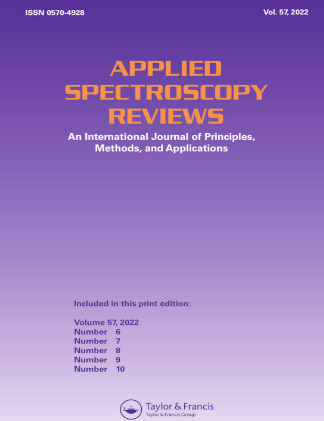An overview of alcoholic beverages discrimination and a study on identification of bland Chinese liquors by 13C-NMR and 1H-NMR spectra
IF 5.4
2区 化学
Q1 INSTRUMENTS & INSTRUMENTATION
引用次数: 2
Abstract
Abstract An overview of alcoholic beverages discrimination plus the author’s experimental research work on identification of bland Chinese liquors is presented in this article. First, a summary was given on analytical techniques combined with multivariate statistical analysis for discrimination problems related to alcoholic beverages; and then, our experimental research was presented on discrimination of different aroma types of Chinese liquors by 1H-Nuclear Magnetic Resonance (NMR) and 13C-NMR combined with multivariate statistical analysis. Principal Component Analysis (PCA) was used to highlight the most significant features from high-dimensional data to acquire visual inspections of NMR spectra in the first step. The representative new score values were used as the input variables for Support Vector Machine (SVM), and the performance of this model was evaluated by Leave-One-Out Cross Validation method (LOOCV). Compared with 1H-NMR, the scores of PCA and predications of the SVM model from 13C-NMR spectra showed more significant separation and better prediction performance. 13C-NMR for multivariate analysis might be a more effective tool for identification of these Chinese liquors because of its complementary component information as well as less spectral overlapping than that in 1H-NMR.酒精饮料鉴别综述及用13C-NMR和1H-NMR鉴别中国白酒的研究
摘要本文介绍了酒精饮料鉴别的概况,以及笔者对中国淡味白酒鉴别的实验研究工作。首先,总结了分析技术与多元统计分析相结合的酒精饮料歧视问题;然后,结合多元统计分析,对1h -核磁共振(NMR)和13c -核磁共振(13C-NMR)对中国白酒不同香气类型的鉴别进行了实验研究。首先利用主成分分析(PCA)从高维数据中突出最显著的特征,获得核磁共振光谱的视觉检测。将具有代表性的新得分值作为支持向量机(SVM)的输入变量,并通过留一交叉验证法(LOOCV)对该模型的性能进行评估。与1H-NMR相比,13C-NMR谱的PCA和SVM模型的预测分数分离更显著,预测性能更好。13C-NMR多变量分析可能是鉴别中国白酒更有效的工具,因为它的成分信息互补,而且光谱重叠比1H-NMR少。
本文章由计算机程序翻译,如有差异,请以英文原文为准。
求助全文
约1分钟内获得全文
求助全文
来源期刊

Applied Spectroscopy Reviews
工程技术-光谱学
CiteScore
13.80
自引率
1.60%
发文量
23
审稿时长
1 months
期刊介绍:
Applied Spectroscopy Reviews provides the latest information on the principles, methods, and applications of all the diverse branches of spectroscopy, from X-ray, infrared, Raman, atomic absorption, and ESR to microwave, mass, NQR, NMR, and ICP. This international, single-source journal presents discussions that relate physical concepts to chemical applications for chemists, physicists, and other scientists using spectroscopic techniques.
 求助内容:
求助内容: 应助结果提醒方式:
应助结果提醒方式:


